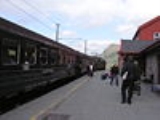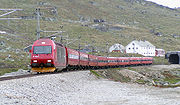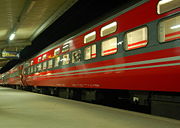
Norwegian railway carriages
Encyclopedia
There are three basic types of Norwegian railway carriage used commonly by NSB
on the Norwegian railway system
, the Class 3, Class 5 and Class 7 series. As of 2005, the carriages are hauled by NSB El 18
engines on the main electrified stretches and NSB Di 4
engines on non-electrified lines.
A B5 carriage is thus the "typical" second-class carriage in the Class 5 series, while an A5 carriage is a first class version of it.
 These carriages were built between 1962 and 1974 by Strømmen
These carriages were built between 1962 and 1974 by Strømmen
and are the oldest carriages in common use. They have four recessed slam doors, two in each end. The carriages are partitioned into two saloons, the second class carriage usually has 60 seats. B3 carriages with a higher passenger density are also used on Flåmsbana
where they are hauled by NSB El 17
engines. A B3 carriage is 23.5 metres long and weighs 36.4 to 42 tonnes.
The WLAB carriages were the older sleeping carriages used on night trains. The cabins had three bunks stacked on top of one another. They were retired from service in January 2006.
The BF13 and BF14 are versions of the B5 with cabins for families with small children and people with physical disabilities. They also have a small conductor's compartment.

 These carriages are the longest ones operated by NSB. They are used mostly for express trains on the Bergen Line, the Dovre Line and the Sørland Line. They were built by Strømmen between 1982 and 1989. The Class 7 is and looks considerably more modern than the Class 3 and Class 5, with convex sides and low "aircraft-style" windows. Most of the B7s have two saloons, a smaller one with 24 seats and a larger with 46 seats. The cars are 26.1 m long and weigh about 45 tonnes (50 tons). Most trains with Class 7 carriages have one car with a playroom for families with children (BC7).
These carriages are the longest ones operated by NSB. They are used mostly for express trains on the Bergen Line, the Dovre Line and the Sørland Line. They were built by Strømmen between 1982 and 1989. The Class 7 is and looks considerably more modern than the Class 3 and Class 5, with convex sides and low "aircraft-style" windows. Most of the B7s have two saloons, a smaller one with 24 seats and a larger with 46 seats. The cars are 26.1 m long and weigh about 45 tonnes (50 tons). Most trains with Class 7 carriages have one car with a playroom for families with children (BC7).
All Class 7 cars underwent extensive refurbishment in the period 2008–2011, including improved facilities for disabled passengers, power outlets at all seats, WiFi and free access to Internet. These cars will be used on the Bergen Line (Oslo–Bergen) and Dovre Line (Oslo–Trondheim), replacing the Class 73
trains.
A usual Class 7 day train consists of 6 or 7 coaches:
A usual Class 7 night train consists of 5 to 7 coaches:
The WLAB2 is the newest, and since the retirement of the old WLAB carriages, the only type of sleeping carriage which is used on night trains
on the Bergen, Dovre Sørland and Nordland Lines. The cabins have one or two bunks depending on the fare the passenger pays.
NSB
-Education:*National Spelling Bee, the Scripps National Spelling Bee, a competition in the US*National Science Bowl, a high school academic competition*Northampton School for Boys, a British Secondary School*North Sydney Boys High School, an Australian high school...
on the Norwegian railway system
Rail transport in Norway
The Norwegian railway system comprises 4,087 km of track of which 2,622 km is electrified and 242 km double track. There are 696 tunnels and 2760 bridges....
, the Class 3, Class 5 and Class 7 series. As of 2005, the carriages are hauled by NSB El 18
NSB El 18
NSB El 18 is a class of 22 electric locomotives built by Adtranz and Swiss Locomotive and Machine Works for the Norwegian State Railways . The class is a modification of the Swiss Federal Railways Re 460 locomotive and built at Adtranz Strømmen in 1996 and 1997...
engines on the main electrified stretches and NSB Di 4
NSB Di 4
The NSB Di 4 is a diesel-electric locomotive used by Norwegian NSB railways to haul passenger trains on stretches which are not electrified. They are used mostly on Nordlandsbanen, since the other unelectrified stretches are usually served by diesel multiple units.The five Di 4s which were built...
engines on non-electrified lines.
Coding
In general the preceding letter of the carriage type indicates what the carriage is used for. For example- A indicates a first class carriage.
- B indicates a second class carriage, this is the most common.
- AB indicates a carriage with both first class and second class seating.
- C indicates some sort of "special" carriage, such as one with a playing room for families with children.
- F indicates a luggage carriage.
- R indicates a restaurant carriage.
- WL indicates a sleeping carSleeping carThe sleeping car or sleeper is a railway/railroad passenger car that can accommodate all its passengers in beds of one kind or another, primarily for the purpose of making nighttime travel more restful. The first such cars saw sporadic use on American railroads in the 1830s and could be configured...
riage.
A B5 carriage is thus the "typical" second-class carriage in the Class 5 series, while an A5 carriage is a first class version of it.
Class 3 series

Strømmens Værksted
Strømmens Værksted A/S was an industrial company based in Skedsmo, Norway, specializing in the production of rolling stock. Founded in 1873, it remains as a part of Bombardier Transportation...
and are the oldest carriages in common use. They have four recessed slam doors, two in each end. The carriages are partitioned into two saloons, the second class carriage usually has 60 seats. B3 carriages with a higher passenger density are also used on Flåmsbana
Flåmsbana
The Flåm Line is a long railway between Myrdal and Flåm in Aurland, Norway. As a branch line of the Bergen Line, it runs through Flåmsdalen and connects the mainline with Sognefjord. The line's elevation difference is . The line has ten stations, twenty tunnels and one bridge. It has a maximum...
where they are hauled by NSB El 17
NSB El 17
The NSB El 17 is a class of twelve electric locomotives built by Thyssen-Henschel and Norsk Elektrisk & Brown Boveri for the Norwegian State Railways . The class was built in two batches, the first delivered in 1982 and numbered 2221–2226, and the second delivered in 1987 and numbered 2227–2232...
engines. A B3 carriage is 23.5 metres long and weighs 36.4 to 42 tonnes.
The WLAB carriages were the older sleeping carriages used on night trains. The cabins had three bunks stacked on top of one another. They were retired from service in January 2006.
Class 5 series
These carriages are visually quite similar to the B3 series. The doors are flush with the car sides and sliding rather than conventional slam doors, and on most carriages, all the seating is in one large saloon. The B5s were built by Strømmen between 1977 and 1981. They are slightly larger than the B3, the specifications are 25.3 m long over buffers, 42 tonnes heavy and seat up to 68 passengers. They are used mostly on mid-distance trains to supplement the Class 70 trainsets.The BF13 and BF14 are versions of the B5 with cabins for families with small children and people with physical disabilities. They also have a small conductor's compartment.
Class 7 series


All Class 7 cars underwent extensive refurbishment in the period 2008–2011, including improved facilities for disabled passengers, power outlets at all seats, WiFi and free access to Internet. These cars will be used on the Bergen Line (Oslo–Bergen) and Dovre Line (Oslo–Trondheim), replacing the Class 73
NSB Class 73
NSB Class 73 is a class of 22 electric multiple units built by Adtranz for the Norwegian State Railways. The four-car trains were modifications of Class 71, which was again based on the Swedish X2. The A-series consists of 16 intercity trains; they were delivered in 1999 and 2000 and are used on...
trains.
A usual Class 7 day train consists of 6 or 7 coaches:
- A7 (1st class)
- BC7 (playroom, wheelchair area)
- B7-6 (2nd class)
- FR7 (bistro)
- 2-3 x B7-4 (2nd class)
A usual Class 7 night train consists of 5 to 7 coaches:
- 2-3 WLAB2 (sleeping coach)
- FR7 (bistro)
- 2-3 x B7-4 (2nd class)
The WLAB2 is the newest, and since the retirement of the old WLAB carriages, the only type of sleeping carriage which is used on night trains
NSB Night Train
NSB Night Train is a night sleeping car service provided by the Norwegian State Railways on four routes; Oslo - Bergen , Oslo - Stavanger , Oslo - Trondheim and Trondheim - Bodø .The service is provided using El 18 locomotives with WLAB2 and B7 cars on the electrified lines in Southern Norway,...
on the Bergen, Dovre Sørland and Nordland Lines. The cabins have one or two bunks depending on the fare the passenger pays.

